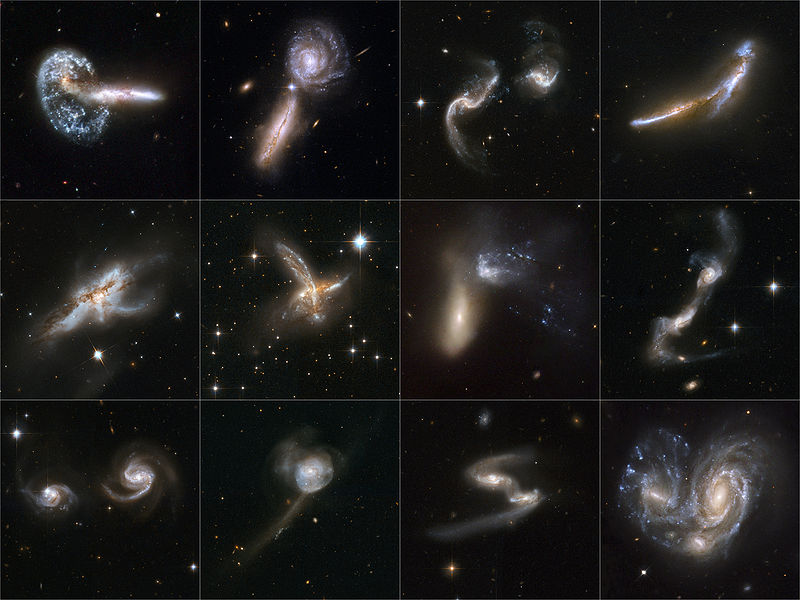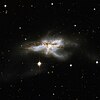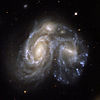| DescriptionGalaxies Gone Wild!.jpg |
English: Caption for the image. Français : Nom des galaxies assemblées ici.
|
| Arp 148, VV 032, Mayall's Object, MCG+07-23-019
|
UGC 9618, VV 340, Arp 302, VV 340A, VV 340B, KPG 446B
|
Arp 256, VV 352, MCG-02-01-051
|
NGC 6670 , NGC 6670A/B, VII Zw 812
|
|
| NGC 6240, VV 617
|
ESO 593-8, ESO 593-IG008
|
NGC 454
|
UGC 8335, VV 250a, Arp 238, KPG 369B
|
|
| NGC 6786, UGC11415, VV 414, KPG 538, LEDA 62867
|
NGC 17, NGC 34*
|
ESO 77-14, ESO 077-IG014, AM 2317-692
|
NGC 6050, IC 1179, Arp 272
|
English: Original NASA caption reads:
"Astronomy textbooks typically present galaxies as staid, solitary, and majestic island worlds of glittering stars.
But galaxies have a wild side. They have flirtatious close encounters that sometimes end in grand mergers and overflowing "maternity wards" of new star birth as the colliding galaxies morph into wondrous new shapes.
Today, in celebration of the Hubble Space Telescope's 18th launch anniversary, 59 views of colliding galaxies constitute the largest collection of Hubble images ever released to the public. This new Hubble atlas dramatically illustrates how galaxy collisions produce a remarkable variety of intricate structures in never-before-seen detail.
Astronomers observe only one out of a million galaxies in the nearby universe in the act of colliding. However, galaxy mergers were much more common long ago when they were closer together, because the expanding universe was smaller. Astronomers study how gravity choreographs their motions in the game of celestial bumper cars and try to observe them in action.
For all their violence, galactic smash-ups take place at a glacial rate by human standards - timescales on the order of several hundred million years. The images in the Hubble atlas capture snapshots of the various merging galaxies at various stages in their collision.
Most of the 59 new Hubble images are part of a large investigation of luminous and ultra- luminous infrared galaxies called the GOALS project (Great Observatories All-sky LIRG Survey). This survey combines observations from Hubble, NASA's Spitzer Space Telescope, NASA's Chandra X-ray Observatory, and NASA's Galaxy Evolution Explorer. The majority of the Hubble observations are led by Aaron S. Evans of the University of Virginia, Charlottesville, the National Radio Astronomy Observatory, and Stony Brook University.
Français : Galaxies en collision, vues par le télescope spatial Hubble. De telles collisions sont très rares (une galaxie par million), mais elles étaient bien plus fréquentes dans le passé lointain, quand l'univers était plus dense. De telles collisions durent plusieurs centaines de millions d'années, et Hubble en a saisi plusieurs à des stades différents. La majorité de ces observations ont été faites sous le contrôle de Aaron S. Evans de l' Université de Virginie à Charlottesville, aux États-Unis.
Українська: Зображення взаємодіючих галактик, отримані космічним телескопом Хаббл. Взаємодіючі галактики це досить рідкісне явище у сьогоднішньому Всесвіті (один випадок на мільйон галактик), хоча для раннього Всесвіту ця ймовірність була більшою, завдяки його більшій густині. Взаємодія (або проникнення галактик одна в одну) розтягується на мільйони років й за допомогою Хаббла людство має можливість відзняти сьогоднішній стан взаємодіючих галактик в деталях. |
| Author |
NASA, ESA, the Hubble Heritage (STScI/AURA)-ESA/Hubble Collaboration, and A. Evans (University of Virginia, Charlottesville/NRAO/Stony Brook University)
|
















